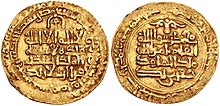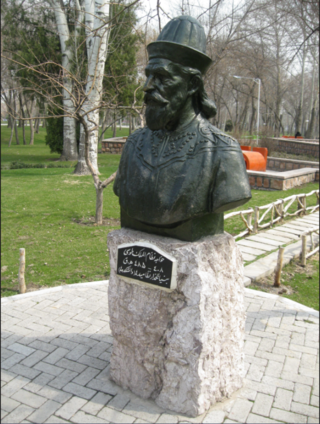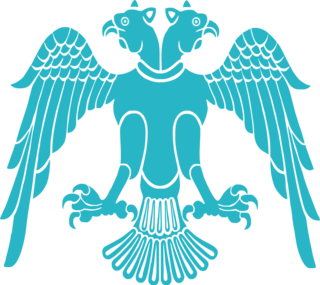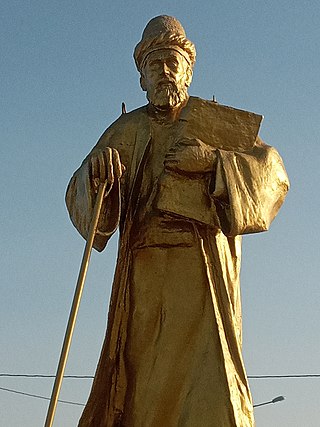
Kara Arslan Ahmad Qavurt (died 1073), better simply known as Qavurt (also spelled Kavurt) was a Seljuq prince. Upon his brother's death, he led an unsuccessful rebellion against his nephew in an attempt to gain the Seljuk throne.

Kara Arslan Ahmad Qavurt (died 1073), better simply known as Qavurt (also spelled Kavurt) was a Seljuq prince. Upon his brother's death, he led an unsuccessful rebellion against his nephew in an attempt to gain the Seljuk throne.
The Seljuq dynasty was a Turkish Sunni Muslim dynasty that established both the Seljuq Empire and Sultanate of Rum, which at their total height stretched from Anatolia through Persia. Qavurt was the son of Çağrı Bey, who was the grandson of Seljuk, the founder of the dynasty. [1] Qavurt's brother Alp Arslan succeeded his uncle Tuğrul as the new sultan and Qavurt then the governor of Kirman (south Persia) waited for his turn.
Alp Arslan died in 1072. But before death he willed his throne to Malik Shah I, his second son. He also expressed his concern about possible throne struggles. The main contestants for the throne were his eldest son Ayaz and his brother Qavurt. As a compromise, he willed generous grants to Ayaz and Qavurt.
Malik Shah was only 17 or 18 years of age when he ascended to throne. Although Ayaz presented no problem, he faced with the serious problem of Qavurt's rebellion. [2] His vizier Nizam al-Mulk was even more worried for he had become the de facto ruler of the empire during young Malik Shah's reign. Although Qavurt had only a small army, Turkmen officiers in Malik Shah's army tended to support Qavurt. So Malik Shah and Nizam al-Mulk added non Turkic regiments to Seljuk army. Artukids also supported Malik Shah. The clash was at a location known as Kerç kapı (or Kerec [3] ) close to Hamedan on 16 May 1073. Malik Shah was able to defeat Qavurt's forces. Although Qavurt escaped, he was soon arrested. Initially Malik Shah was tolerant to his uncle. But Nizam al-Mulk convinced the young sultan to execute Qavurt. Nizam al-Mulk also executed two of Qavurt's four sons. [4] Later he eliminated most of the Turkic commanders of the army whom he suspected to be Qavurt's partisans.
Qavurt's defeat was a blow to Turkic character of the empire. But Qavurt's other sons managed to rule in Kirman as vassals of Malik Shah and their small state lived even longer than that of the Great Seljuk Empire.

Alp Arslan, born Muhammad bin Dawud Chaghri, was the second Sultan of the Seljuk Empire and great-grandson of Seljuk, the eponymous founder of the dynasty. He greatly expanded the Seljuk territory and consolidated his power, defeating rivals to the south and northwest, and his victory over the Byzantines at the Battle of Manzikert, in 1071, ushered in the Turkoman settlement of Anatolia.

Jalāl al-Dawla Mu'izz al-Dunyā Wa'l-Din Abu'l-Fatḥ ibn Alp Arslān, better known by his regnal name of Malik-Shah I, was the third sultan of the Great Seljuk Empire from 1072 to 1092, under whom the sultanate reached its zenith of power and influence.

Abu Ali Hasan ibn Ali Tusi, better known by his honorific title of Nizam al-Mulk was a Persian scholar, jurist, political philosopher and Vizier of the Seljuk Empire. Rising from a lowly position within the empire, he effectively became the de facto ruler of the empire for 20 years after the assassination of Sultan Alp Arslan in 1072, serving as the archetypal "good vizier". Viewed by many historians as "the most important statesman in Islamic history", the policies implemented by Nizam al-Mulk would go on to remain as the basic foundation for administrative state structures in the Muslim world up until the 20th Century.

Ahmad Senjer (Persian: احمد سنجر; full name: Muizz ad-Dunya wa ad-Din Adud ad-Dawlah Abul-Harith Ahmad Sanjar ibn Malik-Shah) (b. 1085 – d. 8 May 1157) was the Seljuq ruler of Khorasan from 1097 until in 1118, when he became the Sultan of the Seljuq Empire, which he ruled until his death in 1157.

Abu Shuja Ghiyath al-Dunya wa'l-Din Muhammad ibn Malik-Shah, better known as Muhammad I Tapar, was the sultan of the Seljuk Empire from 1105 to 1118. He was a son of Malik-Shah I and Taj al-Din Khatun Safariya. In Turkish, Tapar means "he who obtains, finds".

Nasir al-Din Mahmud I was the sultan of the Seljuk Empire from 1092 to 1094. He succeeded Malik Shah I as Sultan, but he did not gain control of the empire built by Malik Shah and Alp Arslan.

Rukn al-Din Abu'l-Muzaffar Berkyaruq ibn Malikshah, better known as Berkyaruq (برکیارق), was the fifth sultan of the Seljuk Empire from 1094 to 1105.

The Seljuk dynasty, or Seljukids, also known as Seljuk Turks, Seljuk Turkomans or the Saljuqids, was an Oghuz Turkic, Sunni Muslim dynasty that gradually became Persianate and contributed to the Turco-Persian tradition in the medieval Middle East and Central Asia. The Seljuks established the Seljuk Empire (1037–1194), the Sultanate of Kermân (1041–1186) and the Sultanate of Rum (1074–1308), which at their heights stretched from Iran to Anatolia and were the prime targets of the First Crusade.
Qutalmish ibn Arslan was a Turkic prince who was a member of Seljukid house in the 11th century. His son Kutalmışoğlu Suleiman, founded the Sultanate of Rum in what is now Turkey.
The Seljuk Empire, or the GreatSeljuk Empire, was a high medieval, culturally Turco-Persian, Sunni Muslim empire, founded and ruled by the Qïnïq branch of Oghuz Turks. It spanned a total area of 3.9 million square kilometres from Anatolia and the Levant in the west to the Hindu Kush in the east, and from Central Asia in the north to the Persian Gulf in the south.

Toghrul III was the last sultan of the Great Seljuk Empire and the last Seljuk Sultan of Iraq. His great uncle Sultan Ghiyath ad-Din Mas'ud had appointed Shams ad-Din Eldiguz as atabeg of his nephew Arslan-Shah, the son of his brother Toghrul II, and transferred Arran to his nephew's possession as iqta in 1136. Eldiguz eventually married Mu’mina Khatun, the widow of Toghril II, and his sons Nusrat al-Din Muhammad Pahlavan and Qizil Arslan Uthman were thus half-brothers of Arslan Shah, but despite close ties with the Royal Seljuk house, Eldiguz had remain aloof of the royal politics, concentrating on repelling the Georgians and consolidating his power. In 1160, Sultan Suleiman-Shah named Arslan Shah his heir and gave him governorship of Arran and Azerbaijan, fearful of the power of Eldiguz.
The Khwarazmian or Khwarezmian Empire was a culturally Persianate, Sunni Muslim empire of Turkic mamluk origin, that ruled large parts of present-day Central Asia, Afghanistan, and Iran in the approximate period of 1077 to 1231, first as vassals of the Seljuk Empire and the Qara Khitai, and from circa 1190 as independent rulers, up until the Mongol conquest in 1219–1221. The Khwarazmian Empire eventually became "the most powerful and aggressively expansionist empire in the Persian lands", defeating the Seljuk Empire and the Ghurid Empire, even threatening the Abbasid caliphate. In the beginning of the 13th century, the empire is thought to have become the greatest power in the Muslim world. It is estimated that the empire spanned an area of 2.3 million square kilometers to 3.6 million square kilometers effectively making it one of the largest land empires in history. The empire, which was modelled on the preceding Seljuk Empire, was defended by a huge cavalry army composed largely of Kipchak Turks.

Amid al-Mulk Abu Nasr al-Kunduri, commonly known as al-Kunduri, was a Persian bureaucrat, who served as the vizier of the first Seljuk Sultan Tughril and his nephew Alp Arslan.
Terken Khatun was the second/third wife and chief consort of Malik Shah I, Sultan of the Seljuk Empire from 1072, until his death in 1092. She was born as a Karakhanid princess, the daughter of Tamghach Khan Ibrahim. She was the mother of Mahmud I, the next ruler of the Seljuk Empire, and regent during his minority in 1092–1094.

The Kerman Seljuk Sultanate was a Persianate Sunni Muslim state, established in the parts of Kerman and Makran which had been conquered from the Buyid dynasty by the Seljuk Empire which was established by the Seljuk dynasty, which was of Oghuz Turkic origin. The Founder of this dynasty, Emadeddin Kara Arslan Ahmad Qavurt who succeeded the ruler of this dynasty after the surrender of the ruler of Buyyids, Abu Kalijar Marzuban. For first time in this period, an independent state was formed in Kerman; eventually, after 150 years, with the invasion of the Ghuzz leader Malik Dinar, the Kerman Seljuk Sultanate fell.

Battle of Kerj Abu Dulaf was fought in 1073 between the Seljuk Army of Malik-Shah I and Kerman Seljuk army of Qavurt and his son, Sultan-shah. It took place approximately near Kerj Abu Dulaf, the present-day between Hamadan and Arak, and was a decisive Malik-Shah I victory.
The High Middle Ages, or Classic Feudalism Period in what constitutes the present-day Republic of Azerbaijan, lasted from around the 11th century to the 15th century AD. The High Middle Ages were preceded by the Early Middle Ages and were followed by the Late Middle Ages, which ended around the 15thcentury AD. Key historical trends of the High Middle Ages include the incorporation of the territories that constitute present-day Azerbaijan into the Seljuk Empire, the establishment of the Eldiguzids, the Mongol invasions and the rule of the Ilkhanate, the invasions of Timur and the establishment of the Turkoman Kara Koyunlu and Aq Qoyunlu tribal confederations.
Savtegin was a prominent emir of the early Seljuk Empire, during the reigns of Tughril I, Alp Arslan, and Malik-Shah I. His full name in Arabic, as given by Münejjim Bāshī Ahmad Effendi, was 'Imād ad-Dawlah Sarhang Sāw Takīn. He first appears in sources during the reign of Tughril I, when he was sent as an ambassador when rumors arose that Ibrahim Yinal would rebel. He later took part in the campaign against Arslan Besasîrî, a Turkic commander under the Buyids who had captured the Abbasid caliph al-Qa'im. Arslan Besasîrî was killed in battle on 18 January 1060. Later, in April–May 1061, Savtegin was part of the delegation sent to Baghdad to negotiate a marriage between Tughril and al-Qa'im's daughter Sayyida.
Sa'd ad-Dawla Gohar-Ā'īn was an 11th-century Turkic eunuch mamluk who served as a government official, diplomat, and military commander for the Seljuk Empire. The name "Gohar-Ā'īn" means "jewel-mirror". Medieval authors had differing opinions about him – Ibn al-Jawzi spoke highly of him, praising "his capability, clear view, and leadership of the army" as well as his "piousness, uprightness and justice". Ibn al-Athir also had a positive opinion of him, saying he "did not take anything for himself from the people of his wilaya". Bundari, on the other hand, spoke negatively of him, calling him "cunning like a dog, something like a beast, a man without penis, a woman without vagina".